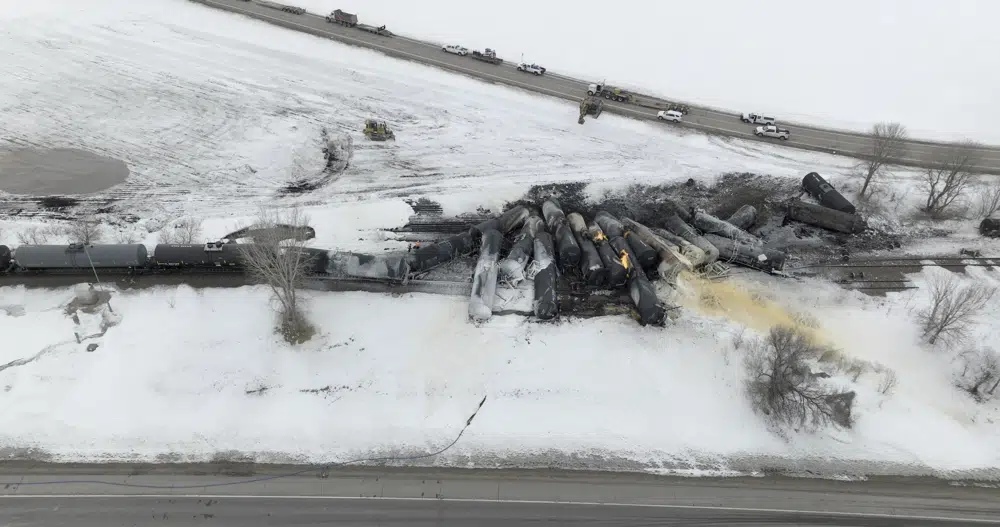Americans are renewing their focus on railroad safety after a string of recent derailments, especially two fiery ones involving hazardous chemicals in Ohio and Minnesota that prompted evacuations.
Federal regulators and members of Congress are urging railroads to do more to prevent derailments. They want standards for the trackside detectors used to help identify equipment problems, more notice to states about hazardous chemicals they are hauling, and at least two people at the helm of freight trains.
A Senate bill would toughen the penalty for safety violations to up to 1% of a railroad’s annual operating income and set standards for the maximum length and weight of freight trains, which have grown significantly in recent years. Trains now routinely stretch beyond two miles (3 kilometers) long.
The railroads themselves say they will take steps that include installing roughly 1,000 more trackside detectors. But the industry has a long history of resisting new regulations. The Association of American Railroads trade group has already spoken out against the crew size rule and requiring electronically-controlled brakes.
Railroads are generally regarded as the safest way to transport hazardous chemicals across land, and statistics show that 99.9% of those shipments arrive safely. Most derailments don’t cause major problems, but there are still nearly three a day somewhere in the country. Just one derailment involving hazardous chemicals can be disastrous.
FLAMMABLE TRAIN RULES
Regulators established a set of safety rules for trains hauling large amounts of crude oil, ethanol or other flammable liquids in 2015 after several fiery derailments, including one of the worst disasters in railroad history.
In 2013, the brakes failed on a parked crude oil train in the hills above the Canadian town of Lac Megantic. The unmanned train rolled downhill and derailed, killing 47 people and causing millions of dollars in damage.
Other crude oil crashes, like one that created a massive fireball outside the town of Casselton, North Dakota, in 2013, alarmed regulators because the number of crude oil shipments had skyrocketed as more oil was being produced in areas without many pipelines, like North Dakota.
The 2015 rules require railroads to notify states about how many flammable liquid trains they expect to transport each week and to find the safest route possible for them. They also establish a maximum speed limit of 50 mph (80 kph).
Neither the Ohio or Minnesota trains that derailed were covered by these rules. To be considered a high-hazardous flammable train, a train must have either a block of 20 or more flammable liquid cars or at least 35 flammable liquid cars in all.
Lawmakers and regulators have discussed expanding the definition, so more trains would be covered.
ELECTRONIC BRAKES
Federal regulators originally proposed that any high-hazardous flammable train would need upgraded electronically-controlled brakes that can stop trains more quickly by applying all cars’ brakes simultaneously. Conventional systems apply air brakes sequentially. But they dropped that proposal in 2018 after Congress required them to conduct a detailed cost-benefit analysis.
Mike Rush, a senior vice president of safety and operations with the AAR trade group, told Federal Railroad Administration officials this week that considering electronic brakes now would be “a complete waste of time.”
He said the major freight railroads spent a decade testing electronic brakes and found only limited benefits. Electronic brakes also were prone to breaking down, he said.
Since 2015, it has become much more common for railroads to use multiple locomotives spread throughout a train. That helps stop trains more quickly because the locomotives can send a braking signal at once — though likely not as quickly as electronic brakes would.
TANK CAR UPGRADES
One thing in the 2015 rules was a requirement to upgrade DOT-111 tank cars used to haul crude oil and ethanol to make them less likely to leak in a derailment. The tank cars involved in Thursday’s BNSF derailment in Minnesota were upgraded triple-hulled DOT-117 cars, but they still ruptured and caught fire.
Since 2015, nearly 48,000 of the newer tank cars have been built, and some 41,000 older tank cars have been upgraded to meet a 2029 deadline set by Congress. Another 35,000 older tank cars need to be upgraded or replaced.
Transportation Secretary Pete Buttigieg suggested speeding up those upgrades to complete them by 2025 after the Ohio derailment. But the Railway Supply Institute, which represents big tank car manufacturers that own most of the nation’s tank cars, says that’s not possible because of current labor and supply chain shortages.
CHEMICAL CONCERNS
The ethanol that spilled and caught fire in the Minnesota derailment is less of a concern than the vinyl chloride that was released after the Ohio derailment or other toxic chemicals railroads routinely carry, like chlorine gas that was released during a 2005 derailment in Graniteville, South Carolina, killing nine people and injuring more than 250.
Ethanol is relatively clean burning, but contaminated soil in the area will have to be removed.
The vinyl chloride released from tank cars in Ohio out of fear it might explode is associated with increased risk of certain cancers. Officials warned when they burned it that two concerning gases — hydrogen chloride and phosgene, which was used as a weapon in World War I — might be released in the process.
That’s why so many East Palestine residents remain concerned about potential long-term health impacts even though state and federal officials insist they haven’t found alarming levels of chemicals in the air or water. Norfolk Southern has also been ordered to test for dioxins, which may have been released during the February incineration.
(AP)











